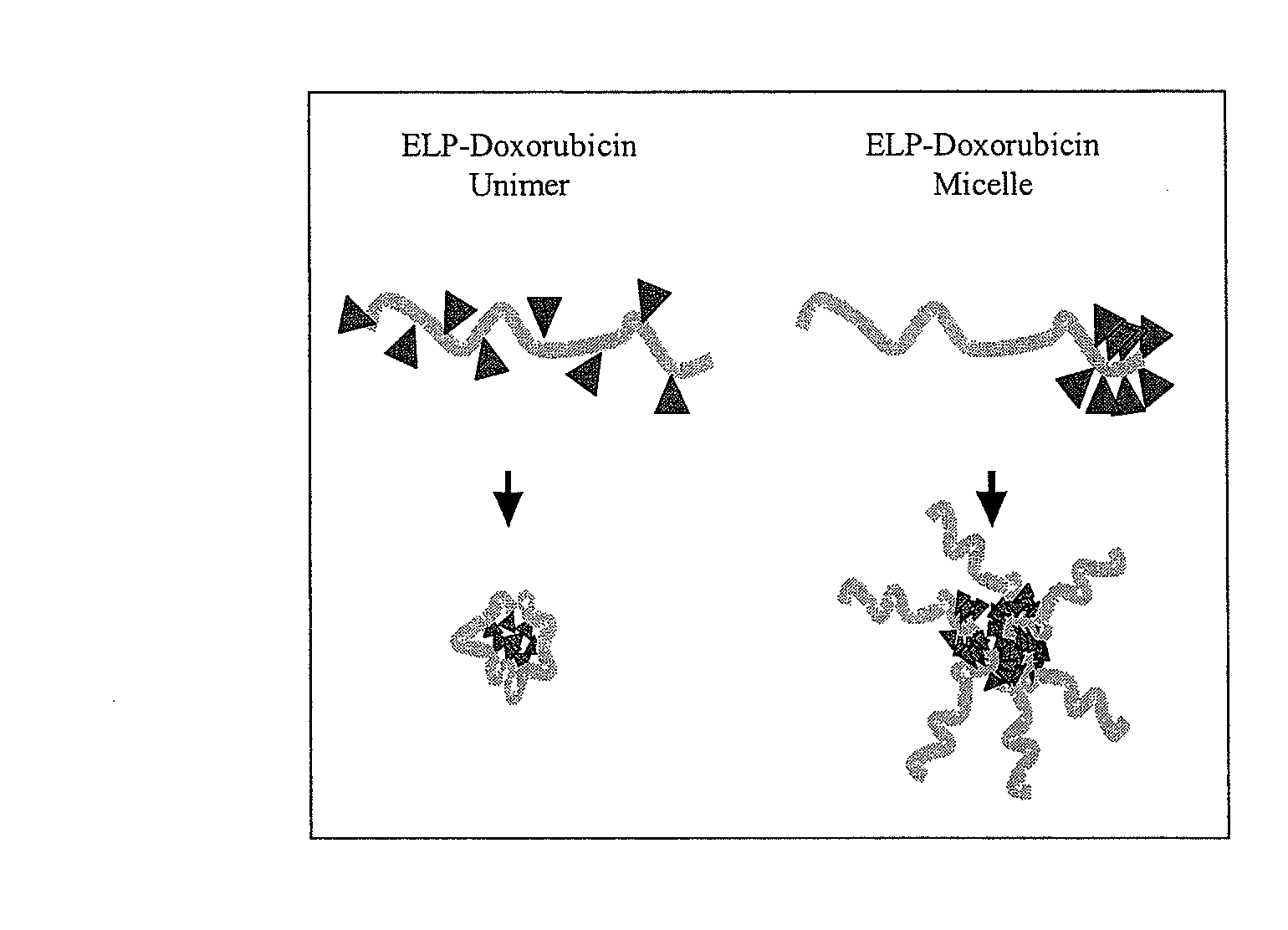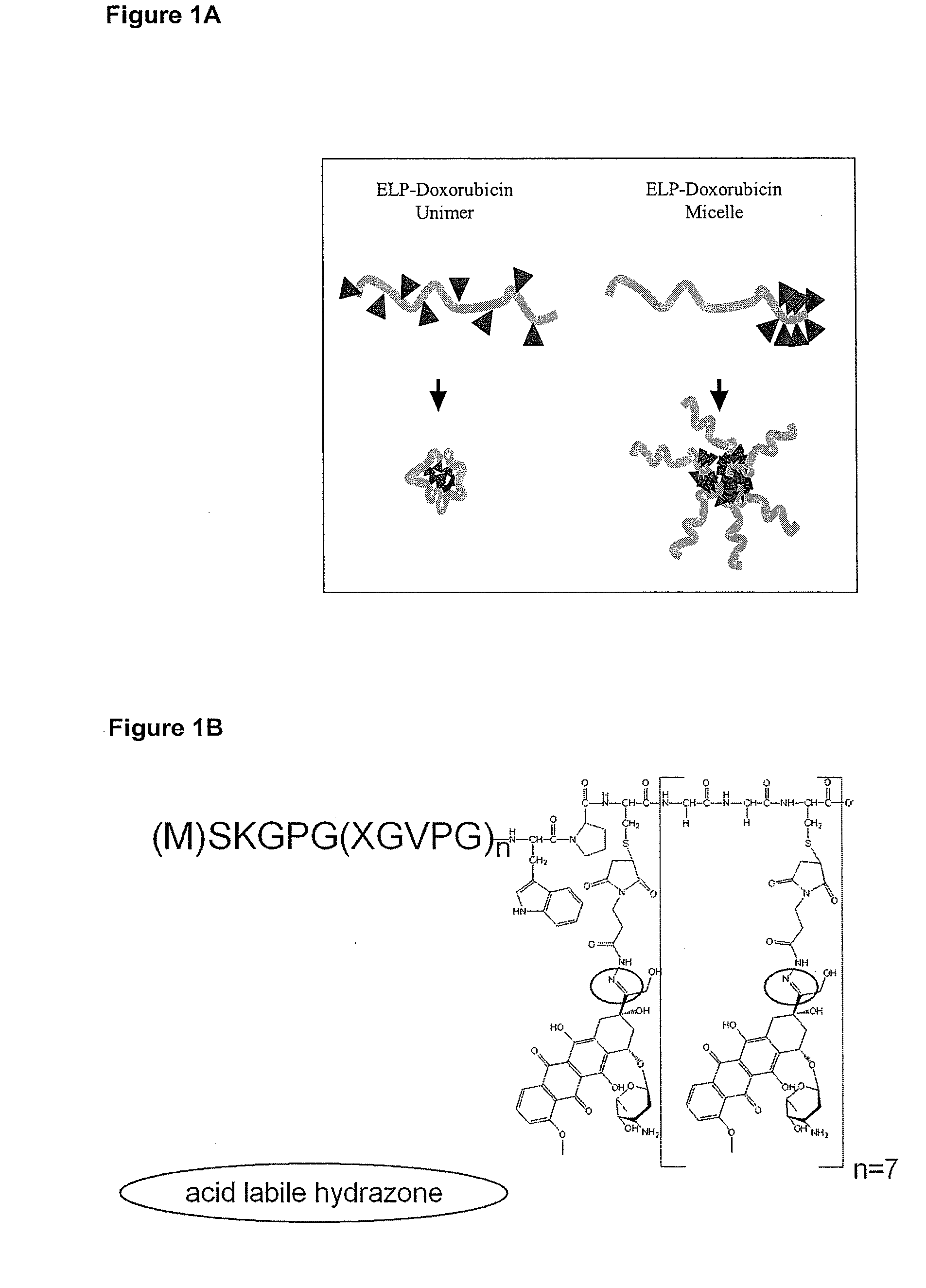Methods and compositions for modulating drug-polymer architecture, pharmacokinetics and biodistribution
a drug-polymer and architecture technology, applied in the direction of drug compositions, peptides, peptides/protein ingredients, etc., can solve the problem of hampered use of these drugs in healthy tissues of the body, and achieve the effect of reducing the toxicity of the drug, and improving the pharmacokinetics of the drug
- Summary
- Abstract
- Description
- Claims
- Application Information
AI Technical Summary
Problems solved by technology
Method used
Image
Examples
example 1
Generation of Doxorubicin-ELP Drug-Polymer
[0080]Approximately 5 doxorubicin molecules were attached to the end of an ELP polymer. The resulting drug-polymer was shown to form micelles (see Example 2 below). The ELP in Table I were produced in E. coli and attached via cysteine-maleimide chemistry to a hydrazone activated doxorubicin[1]. The specific C-terminal sequence used in this experiment was: ELP-Cys-Gly-Gly-Cys-Gly-Gly-Cys-Gly-Gly-Cys-Gly-Gly-Cys-Gly-Gly-Cys-Gly-Gly-Cys-Gly-Gly-Cys (SEQ ID NO:6; ELP=ELP2 in Table I).
TABLE IChemico-Physical Properties of Doxorubicin-ELP Conjugates.ArchitectureUnimerMicelleELPELP10PBELP2SequencePeptideMSKGPG(XGVPG)160WPMSKGPG(XGVPG)160WPC(GGC)7SequenceGuestV:A:G:C [1:7:7:1]V:A:G [1:8:7]Residues (X)Molecular.61.562.8weight (kD)1Drug per4.8 ± 0.14.8 ± 1.3ELP2rH (nm)8.0 ± 0.814.7 ± 1.7 3IC50 (μM)—2.0 ± 1.24pH 7.4−3 ± 4 1 ± 1release (%)5pH 5.099 ± 1768 ± 3 release, a (%)5pH 5.03.9 ± 1.54.9 ± 0.5t1 / 2 (hrs)1ELP concentration determined by BCA assay aga...
example 2
ELP with Doxorubicin Tails Form Micelle Structures
[0082]The doxorubicin-ELP conjugate described in Example 1 and FIG. 1B was tested by two methods to determine if micelles are present under physiological salt and temperature. Dynamic light scattering was used to determine the hydrodynamic radius of particles formed by the chemical species in FIG. 1B. Similar sized particles were confirmed using Freeze Fracture Transmission Electron microscopy. The data in FIG. 2 show that ELP with doxorubicin tails form multimeric, micelle-like structures.
[0083]In contrast, the attachment of doxorubicin at equally distributed points along the ELP backbone prevents the formation of micelles. The specific sequence for this polymer is indicated in Table I (ELP10PB; SEQ ID NO:4). This molecule is referred to herein as a unimer or unimeric. FIG. 3 is a graph demonstrating the hydrodynamic radius for unimeric and micelle formulations of doxorubicin-ELP. Dynamic light scattering was used to determine the h...
example 3
Doxorubicin Attachment Decreases the Transition Temperature for ELP
[0084]Hydrophobic compounds can significantly alter the apparent transition temperature (Tt), of polymers, and this was shown to be case for both micelle and unimeric ELP over a range of concentrations (FIG. 4). FIGS. 4A-4B are graphs showing transition temperatures as a function of concentration for ELP and doxorubicin-ELP. The transition temperatures for these formulations were determined in PBS by measuring the turbidity at a 350 nm wavelength as a function of temperature. Each graph shows the Tt of parent ELP with and without attached doxorubicin (FIG. 4A is the micelle sequence, SEQ ID NO:3, and FIG. 4B is the unimer sequence, SEQ ID NO:4). Micelle and unimer formulations were determined to have a similar drug loading capacity, i.e. ˜5 doxorubicin / ELP. The lines in FIGS. 4A-4B indicate the best fit linear regression to the equation Tt=m Log10 [C]+b.
PUM
| Property | Measurement | Unit |
|---|---|---|
| radius | aaaaa | aaaaa |
| radius | aaaaa | aaaaa |
| body weight | aaaaa | aaaaa |
Abstract
Description
Claims
Application Information
 Login to View More
Login to View More - R&D
- Intellectual Property
- Life Sciences
- Materials
- Tech Scout
- Unparalleled Data Quality
- Higher Quality Content
- 60% Fewer Hallucinations
Browse by: Latest US Patents, China's latest patents, Technical Efficacy Thesaurus, Application Domain, Technology Topic, Popular Technical Reports.
© 2025 PatSnap. All rights reserved.Legal|Privacy policy|Modern Slavery Act Transparency Statement|Sitemap|About US| Contact US: help@patsnap.com



